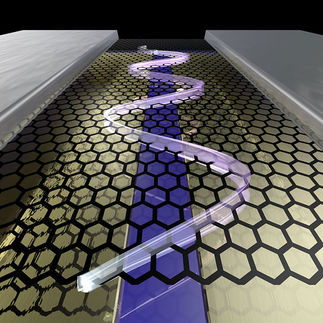Fast detector for a wide wavelength range
Advertisement
Free-electron lasers are extremely versatile research tools because their intense, super short light flashes permit a closer look at new materials and even biological molecules; thus, allowing effects to be observed that had not been known previously. For pulsed lasers in the far infrared range, the so-called terahertz range, scientists at the Helmholtz-Zentrum Dresden-Rossendorf (HZDR) have developed a robust and fast detector which can measure the arrival of a terahertz pulse with great accuracy. The results were published in the scientific journal Applied Physics Letters.
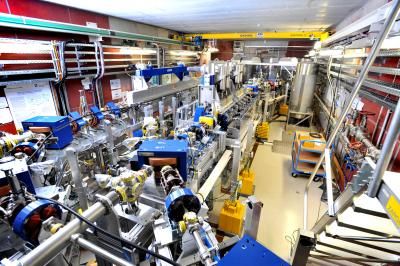
Two free-electron lasers at the HZDR deliver short and intense Terahertz pulses.
HZDR/Frank Bierstedt
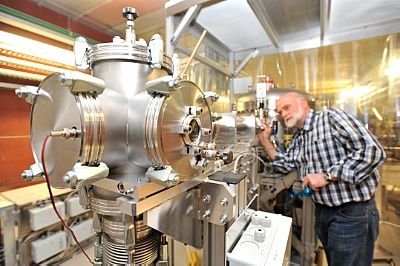
Physicist Dr. Wolfgang Seidel working at the free-electron laser of the HZDR.
HZDR/Frank Bierstedt
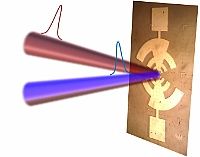
Two laser pulses hit the Graphen detector.
Martin Mittendorff
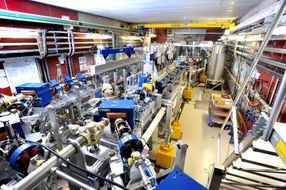
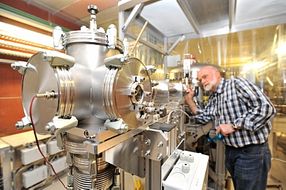
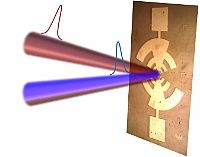
Every individual pulse coming from the Helmholtz-Zentrum Dresden-Rossendorf's Free-Electron Laser (FEL) consists of countless light particles. For many experiments, it's very important to know the precise arrival time of these light pulses. The elapsed time in-between these short light flashes that last only for ten picoseconds, i.e. a ten trillionth of a second, is actually 77,000 picoseconds long. If this elapsed time were transferred to spatial dimensions, then the distance between two pulses would translate into almost eight kilometers. This distance needs to be examined in order to determine the arrival time of a light pulse which would barely be a meter long in this comparison.
Together with scientists from the University of Regensburg, physicist Martin Mittendorff and his colleagues from the HZDR managed to develop, build, and test a reliable detector to measure the time in the terahertz range at free-electron lasers. This technology can be applied in all comparable FELs. It is based on a tiny flake of graphene, a material from which a veritable research boom has arisen since its discovery and for which the Nobel Prize was awarded in 2010. The list of applications for this material – consisting of a layer of carbon which is exactly one atom layer thick –, which seems to have been created especially for the new technologies, is getting constantly longer. Graphene is not just thin, transparent, and stable; it can also absorb light in the invisible infrared range and electrons can move very quickly through the material.
"The ability of graphene to absorb light particles over a very wide wavelength range was a prerequisite for our robust detector that even works at room temperature. The high mobility of electrons in graphene actually permits the high speed," explains Martin Mittendorff from the HZDR. In order to direct the light pulses onto the flake which is no bigger than the tip of a pencil, it is also necessary to use a special antenna. Once the detector concept had been established, physicist Josef Kamann from Professor Dieter Weiss's workgroup at the University of Regensburg built the first prototype. The detector proved to be fast and consistent in all the tests carried out at the HZDR's Free-Electron Laser. In the past, it was difficult to adjust the laser pulses because fast and simple detectors for FEL radiation did not exist in the terahertz range. Especially since most of the fast detectors are limited to a narrow wavelength range and not applicable for large sections of the mid and far infrared range like the HZDR's detector which is based on graphene. Martin Mittendorff and his colleagues are now developing their system further so that it will cover an even wider wavelength range, starting with ultraviolet light and going all the way into the far infrared range.
In particular, when it comes to so-called pump-probe experiments, researchers can really benefit from the new device because they need light from two different laser sources which they then have to synchronize to one another with the greatest precision. The ELBE Center for High-Power Radiation Sources in Rossendorf provides many opportunities for using this newly developed detector system because here, two free-electron lasers (FELBE) with terahertz and/or infrared radiation are united under one roof with the innovative TELBE source which will expand the available spectral range of the terahertz radiation considerably in the HZDR over the next couple of years.



